COPYRIGHT, PLEASE NOTE
All the material on this website is copyrighted to J-P Metsavainio, if not otherwise stated. Any content on this website may not be reproduced without the author’s permission.
BUY A MUSEUM QUALITY POSTER
BUY A POSTER:https://astroanarchy.zenfolio.com/
Monday, November 9, 2009
The power of Tone Mapping
I like to show an example of Tone Mapping procedure.
I have used this method now about two years with very good results.
A PDF-document of the Tone Mapping can be found HERE.
NOTE! Images have to be perfectly calibrated and gradient free to this method to work.
-
The image of Sharpless catalog objects Sh2-223, 224 and 225 shows two extremely dim supernova remnants in a same Three degrees field of view.
Original Post about this image can be found here:
http://astroanarchy.blogspot.com/2009/04/sh2-223-224-and-225-lightened-up.html
As can be seen, in Stacked and Stretched 16h H-alpha image, nearly nothing can be seen under a massive Star field.

In the next image objects can be clearly seen after a Star removal procedure.
If Stars are removed with care, no information from actual target is lost.
If there is some minor details lost during a procedure, they are placed back automaticly, when Stars are placed back to a image.

When Stars are removed, it's easy to use Levels and Curves to boost actual data. There is now no need to worry about bloating Stars.
Since Stars has no relevant color information in a Narrowband image, this method can be used. In a Broad band RGB-image stars has real colors.
The same method can be used for RGB-image as well, if Star information is handeld correctly and replaced back to an image after manipulation.
Stars are placed back as a "Screen mode" under the PhotoShop

A "Color Map", from S-II, H-a, and O-III channels (Starless)

This image has all the color information from the Starless channels combined to a HST-palette.
I call it to a "Color Map".
In HST-color palette, the idea is balance colors so, that no line is dominatring the color scheme.
Usually the H-a is the strongest channel and HST images tend to have a strong Green cast doe that.
With this method, channels are easy to stretch equal, since there is no stars to worry about.
Very weak signal can be used, but it's allways better to have enough signal to work with.
A final image

The final image combined from a Tone Map and Color Map images.
As can be seen in a image, there is no Purple halos around stars, as typically seen in a HST-palette images, doe the strong stretching usually needed for a weaker channels.
In this image Stars are placed back. Whan stars are in separate layer over the Starless image, the tranparency can be tweaked carefully to balance visibility of Stars and Objects.
There is several methods to combine Stars and Objects. Stars can be placed as a Lighten mode in PS or by using the Screen mode. The right method depends of imagetype and some testing is needed by a user. Images can be combined by simply stacking them to gether as well.
We can't use H-a as a luminance alone, since it doesn't containe any information from other channels.
the weak signal from S-II and O-III channels is added to a H-a luminance
by a method descripted in a Tone Mapping PDF-document.
The result can be seen in the image above.
-
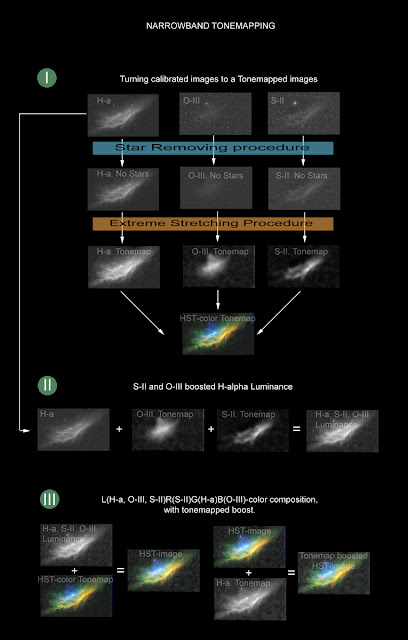
-
Please, if you have tested this method, send a comment here.
Direct link to a you Tone Mapped image could be nice as well.
I need some feedback to be able to further improve this Work flow.
Labels:
research and development
Wednesday, November 4, 2009
RGB and Narrowban data Testing
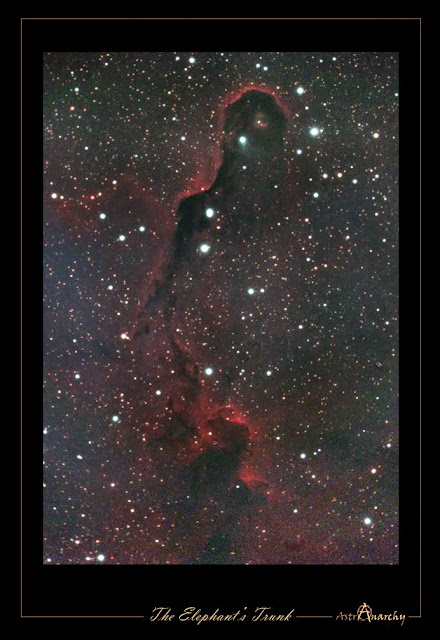 Original RGB-image from 2007
Original RGB-image from 2007 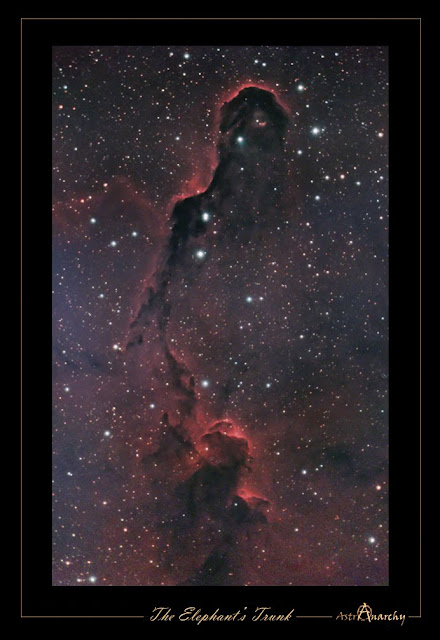 RGB + Natural color narrowband data 50%/50%
RGB + Natural color narrowband data 50%/50% 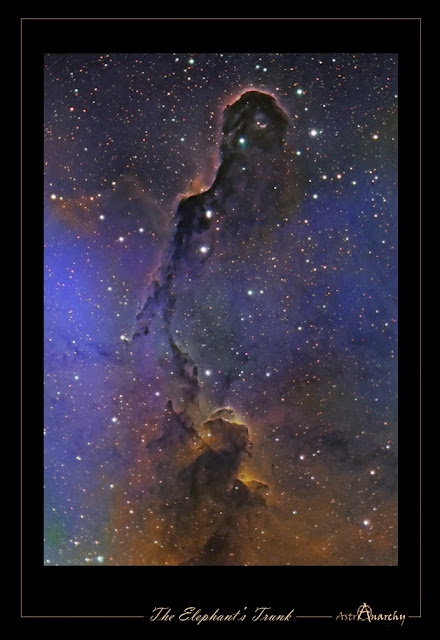 RGB + HST-narrowband. Mixed 40% as luminance/60%HST + star color 100% from RGB - -
RGB + HST-narrowband. Mixed 40% as luminance/60%HST + star color 100% from RGB - -
I found an older RGB-image of Elephant's Trunk Nebula, from year 2007.
It's imaged with a UHC-s filter. this filter gives real Star colors. Camera was a single shot QHY8 cooled astro camera.
Exposures for RGB image:
Meade LX200 Gps 12"@f6.3 with a UHC-s filter, 5x900s only.
-
I have combined this RGB image to a reacently imaged narrowband data.
Interesting looking combination, softer look and real Star colors.
Labels:
research and development
Saturday, October 31, 2009
Elephant's Trunk as a Stereogram
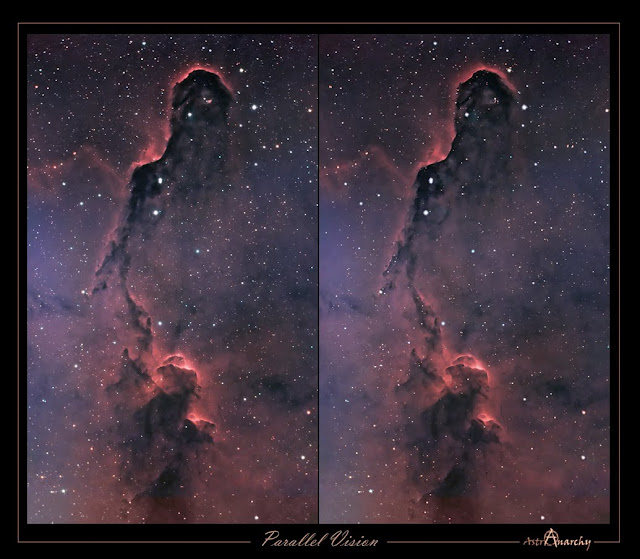 For Parallel Vision
For Parallel Vision 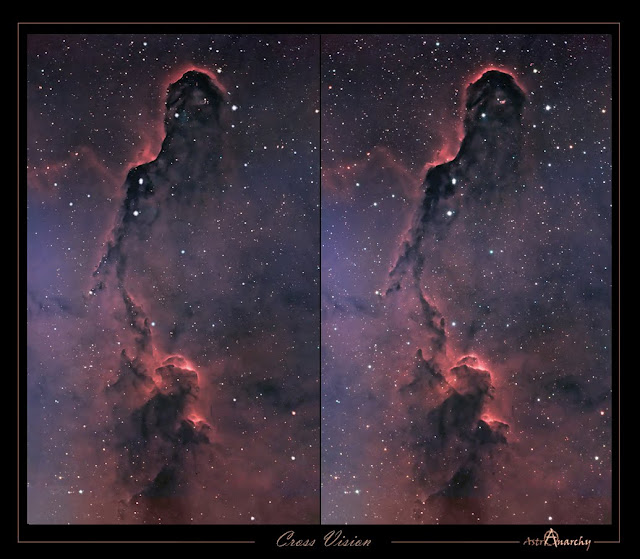 For Cross Vision -
For Cross Vision -
NOTE! This is a personal vision about forms and shapes, based on some known facts and artistic impression. Wieving instructions can be found from a Right hand side menu. - Original Image with details can be found HERE.
Labels:
stereo images
LRGB Elephant's Trunk
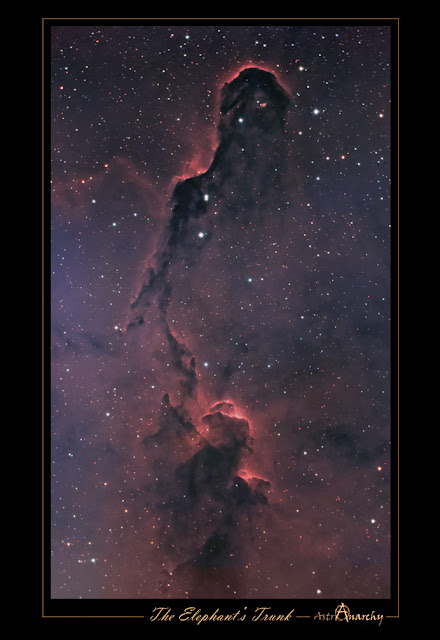
I had an older version of the Elephant's Trunk from the year 2007.
It was a H-aRGB image.
This is a combination of the olde and the new images.
It can be called to a H-a, O-III and S-II boosted RGB image.
Subscribe to:
Posts (Atom)








